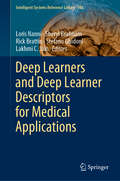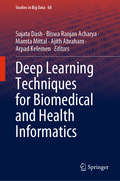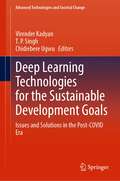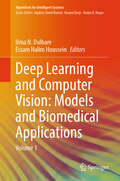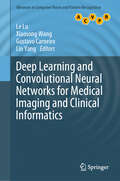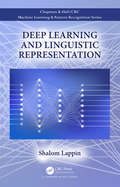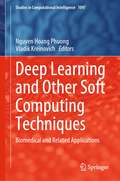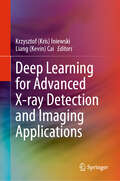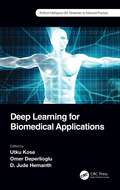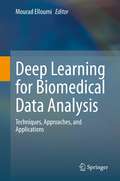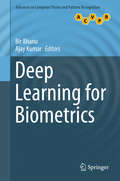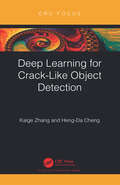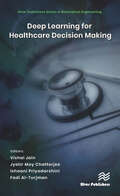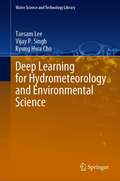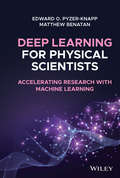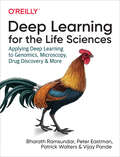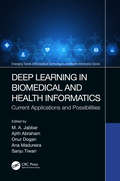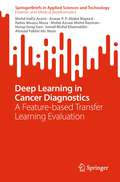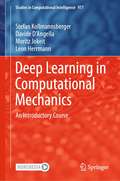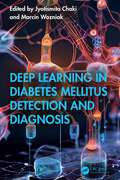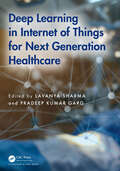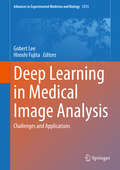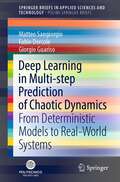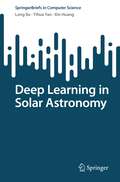- Table View
- List View
Deep Learners and Deep Learner Descriptors for Medical Applications (Intelligent Systems Reference Library #186)
by Lakhmi C. Jain Sheryl Brahnam Loris Nanni Stefano Ghidoni Rick BrattinThis book introduces readers to the current trends in using deep learners and deep learner descriptors for medical applications. It reviews the recent literature and presents a variety of medical image and sound applications to illustrate the five major ways deep learners can be utilized: 1) by training a deep learner from scratch (chapters provide tips for handling imbalances and other problems with the medical data); 2) by implementing transfer learning from a pre-trained deep learner and extracting deep features for different CNN layers that can be fed into simpler classifiers, such as the support vector machine; 3) by fine-tuning one or more pre-trained deep learners on an unrelated dataset so that they are able to identify novel medical datasets; 4) by fusing different deep learner architectures; and 5) by combining the above methods to generate a variety of more elaborate ensembles. This book is a value resource for anyone involved in engineering deep learners for medical applications as well as to those interested in learning more about the current techniques in this exciting field. A number of chapters provide source code that can be used to investigate topics further or to kick-start new projects.
Deep Learning Applications in Medical Image Segmentation: Overview, Approaches, and Challenges
by Sajid Yousuf Bhat Aasia Rehman Muhammad AbulaishApply revolutionary deep learning technology to the fast-growing field of medical image segmentation Precise medical image segmentation is rapidly becoming one of the most important tools in medical research, diagnosis, and treatment. The potential for deep learning, a technology which is already revolutionizing practice across hundreds of subfields, is immense. The prospect of using deep learning to address the traditional shortcomings of image segmentation demands close inspection and wide proliferation of relevant knowledge. Deep Learning Applications in Medical Image Segmentation meets this demand with a comprehensive introduction and its growing applications. Covering foundational concepts and its advanced techniques, it offers a one-stop resource for researchers and other readers looking for a detailed understanding of the topic. It is deeply engaged with the main challenges and recent advances in the field of deep-learning-based medical image segmentation. Readers will also find: Analysis of deep learning models, including FCN, UNet, SegNet, Dee Lab, and many moreDetailed discussion of medical image segmentation divided by area, incorporating all major organs and organ systemsRecent deep learning advancements in segmenting brain tumors, retinal vessels, and inner ear structuresAnalyzes the effectiveness of deep learning models in segmenting lung fields for respiratory disease diagnosisExplores the application and benefits of Generative Adversarial Networks (GANs) in enhancing medical image segmentationIdentifies and discusses the key challenges faced in medical image segmentation using deep learning techniquesProvides an overview of the latest advancements, applications, and future trends in deep learning for medical image analysis Deep Learning Applications in Medical Image Segmentation is ideal for academics and researchers working with medical image segmentation, as well as professionals in medical imaging, data science, and biomedical engineering.
Deep Learning Techniques for Biomedical and Health Informatics (Studies in Big Data #68)
by Ajith Abraham Mamta Mittal Sujata Dash Biswa Ranjan Acharya Arpad KelemenThis book presents a collection of state-of-the-art approaches for deep-learning-based biomedical and health-related applications. The aim of healthcare informatics is to ensure high-quality, efficient health care, and better treatment and quality of life by efficiently analyzing abundant biomedical and healthcare data, including patient data and electronic health records (EHRs), as well as lifestyle problems. In the past, it was common to have a domain expert to develop a model for biomedical or health care applications; however, recent advances in the representation of learning algorithms (deep learning techniques) make it possible to automatically recognize the patterns and represent the given data for the development of such model. This book allows new researchers and practitioners working in the field to quickly understand the best-performing methods. It also enables them to compare different approaches and carry forward their research in an important area that has a direct impact on improving the human life and health. It is intended for researchers, academics, industry professionals, and those at technical institutes and R&D organizations, as well as students working in the fields of machine learning, deep learning, biomedical engineering, health informatics, and related fields.
Deep Learning Technologies for the Sustainable Development Goals: Issues and Solutions in the Post-COVID Era (Advanced Technologies and Societal Change)
by T. P. Singh Virender Kadyan Chidiebere UgwuThis book provides insights into deep learning techniques that impact the implementation strategies toward achieving the Sustainable Development Goals (SDGs) laid down by the United Nations for its 2030 agenda, elaborating on the promises, limits, and the new challenges. It also covers the challenges, hurdles, and opportunities in various applications of deep learning for the SDGs. A comprehensive survey on the major applications and research, based on deep learning techniques focused on SDGs through speech and image processing, IoT, security, AR-VR, formal methods, and blockchain, is a feature of this book. In particular, there is a need to extend research into deep learning and its broader application to many sectors and to assess its impact on achieving the SDGs. The chapters in this book help in finding the use of deep learning across all sections of SDGs. The rapid development of deep learning needs to be supported by the organizational insight and oversight necessary for AI-based technologies in general; hence, this book presents and discusses the implications of how deep learning enables the delivery agenda for sustainable development.
Deep Learning and Computer Vision: Volume 1 (Algorithms for Intelligent Systems)
by Uma N. Dulhare Essam Halim HousseinThis book takes a balanced approach between theoretical understanding and real time applications. All topics show how to explore, build, evaluate and optimize deep learning models with computer vision. Deep learning is integrated with computer vision to enhance the performance of image classification with localization, object detection, object recognition, object segmentation, image style transfer, image colorization, image reconstruction, image super-resolution, image synthesis, motion detection, pose estimation, semantic segmentation in biomedical field. Huge number of efficient approaches/applications and models support medical decisions in the fields of cardiology, dermatology, and radiology. The content of book elaborates deep learning models such as convolution neural networks, deep learning, generative adversarial network, long short-term memory networks (LSTM), autoencoder (AE), restricted Boltzmann machine (RBM), self-organizing map (SOM), deep belief network (DBN), etc.
Deep Learning and Convolutional Neural Networks for Medical Imaging and Clinical Informatics (Advances in Computer Vision and Pattern Recognition)
by Gustavo Carneiro Le Lu Lin Yang Xiaosong WangThis book reviews the state of the art in deep learning approaches to high-performance robust disease detection, robust and accurate organ segmentation in medical image computing (radiological and pathological imaging modalities), and the construction and mining of large-scale radiology databases. It particularly focuses on the application of convolutional neural networks, and on recurrent neural networks like LSTM, using numerous practical examples to complement the theory. The book’s chief features are as follows: It highlights how deep neural networks can be used to address new questions and protocols, and to tackle current challenges in medical image computing; presents a comprehensive review of the latest research and literature; and describes a range of different methods that employ deep learning for object or landmark detection tasks in 2D and 3D medical imaging. In addition, the book examines a broad selection of techniques for semantic segmentation using deep learning principles in medical imaging; introduces a novel approach to text and image deep embedding for a large-scale chest x-ray image database; and discusses how deep learning relational graphs can be used to organize a sizable collection of radiology findings from real clinical practice, allowing semantic similarity-based retrieval.The intended reader of this edited book is a professional engineer, scientist or a graduate student who is able to comprehend general concepts of image processing, computer vision and medical image analysis. They can apply computer science and mathematical principles into problem solving practices. It may be necessary to have a certain level of familiarity with a number of more advanced subjects: image formation and enhancement, image understanding, visual recognition in medical applications, statistical learning, deep neural networks, structured prediction and image segmentation.
Deep Learning and Linguistic Representation (Chapman And Hall/crc Machine Learning And Pattern Recognition Ser.)
by Shalom LappinThe application of deep learning methods to problems in natural language processing has generated significant progress across a wide range of natural language processing tasks. For some of these applications, deep learning models now approach or surpass human performance. While the success of this approach has transformed the engineering methods of machine learning in artificial intelligence, the significance of these achievements for the modelling of human learning and representation remains unclear. Deep Learning and Linguistic Representation looks at the application of a variety of deep learning systems to several cognitively interesting NLP tasks. It also considers the extent to which this work illuminates our understanding of the way in which humans acquire and represent linguistic knowledge. Key Features: combines an introduction to deep learning in AI and NLP with current research on Deep Neural Networks in computational linguistics. is self-contained and suitable for teaching in computer science, AI, and cognitive science courses; it does not assume extensive technical training in these areas. provides a compact guide to work on state of the art systems that are producing a revolution across a range of difficult natural language tasks.
Deep Learning and Other Soft Computing Techniques: Biomedical and Related Applications (Studies in Computational Intelligence #1097)
by Vladik Kreinovich Nguyen Hoang PhuongThis book focuses on the use of artificial intelligence (AI) and computational intelligence (CI) in medical and related applications. Applications include all aspects of medicine: from diagnostics (including analysis of medical images and medical data) to therapeutics (including drug design and radiotherapy) to epidemic- and pandemic-related public health policies.Corresponding techniques include machine learning (especially deep learning), techniques for processing expert knowledge (e.g., fuzzy techniques), and advanced techniques of applied mathematics (such as innovative probabilistic and graph-based techniques).The book also shows that these techniques can be used in many other applications areas, such as finance, transportation, physics. This book helps practitioners and researchers to learn more about AI and CI methods and their biomedical (and related) applications—and to further develop this important research direction.
Deep Learning for Advanced X-ray Detection and Imaging Applications
by Krzysztof Kris Iniewski Liang Kevin CaiThis book provides a comprehensive overview of the latest advances in applying Artificial Intelligence (AI) to advanced X-ray imaging, with a particular focus on its medical applications. Readers will discover why AI is set to revolutionize traditional signal processing and image reconstruction with vastly improved performance. The authors illustrate how Machine Learning (ML) and Deep Learning (DL) significantly advance X-ray detection analysis, image reconstruction, and other crucial steps. This book also reveals how these technologies enable photon counting detector-based X-ray Computed Tomography (CT), which has the potential not only to improve current CT images but also enable new clinical applications, such as providing higher spatial resolution, better soft tissue contrast, K-edge imaging, and simultaneous multi-contrast agent imaging.
Deep Learning for Biomedical Applications (Artificial Intelligence (AI): Elementary to Advanced Practices)
by D. Jude Hemanth Utku Kose Omer DeperliogluThis book is a detailed reference on biomedical applications using Deep Learning. Because Deep Learning is an important actor shaping the future of Artificial Intelligence, its specific and innovative solutions for both medical and biomedical are very critical. This book provides a recent view of research works on essential, and advanced topics. The book offers detailed information on the application of Deep Learning for solving biomedical problems. It focuses on different types of data (i.e. raw data, signal-time series, medical images) to enable readers to understand the effectiveness and the potential. It includes topics such as disease diagnosis, image processing perspectives, and even genomics. It takes the reader through different sides of Deep Learning oriented solutions. The specific and innovative solutions covered in this book for both medical and biomedical applications are critical to scientists, researchers, practitioners, professionals, and educations who are working in the context of the topics.
Deep Learning for Biomedical Data Analysis: Techniques, Approaches, and Applications
by Mourad ElloumiThis book is the first overview on Deep Learning (DL) for biomedical data analysis. It surveys the most recent techniques and approaches in this field, with both a broad coverage and enough depth to be of practical use to working professionals. This book offers enough fundamental and technical information on these techniques, approaches and the related problems without overcrowding the reader's head. It presents the results of the latest investigations in the field of DL for biomedical data analysis. The techniques and approaches presented in this book deal with the most important and/or the newest topics encountered in this field. They combine fundamental theory of Artificial Intelligence (AI), Machine Learning (ML) and DL with practical applications in Biology and Medicine. Certainly, the list of topics covered in this book is not exhaustive but these topics will shed light on the implications of the presented techniques and approaches on other topics in biomedical data analysis. The book finds a balance between theoretical and practical coverage of a wide range of issues in the field of biomedical data analysis, thanks to DL. The few published books on DL for biomedical data analysis either focus on specific topics or lack technical depth. The chapters presented in this book were selected for quality and relevance. The book also presents experiments that provide qualitative and quantitative overviews in the field of biomedical data analysis. The reader will require some familiarity with AI, ML and DL and will learn about techniques and approaches that deal with the most important and/or the newest topics encountered in the field of DL for biomedical data analysis. He/she will discover both the fundamentals behind DL techniques and approaches, and their applications on biomedical data. This book can also serve as a reference book for graduate courses in Bioinformatics, AI, ML and DL. The book aims not only at professional researchers and practitioners but also graduate students, senior undergraduate students and young researchers. This book will certainly show the way to new techniques and approaches to make new discoveries.
Deep Learning for Biometrics (Advances in Computer Vision and Pattern Recognition)
by Bir Bhanu Ajay KumarThis timely text/reference presents a broad overview of advanced deep learning architectures for learning effective feature representation for perceptual and biometrics-related tasks. The text offers a showcase of cutting-edge research on the use of convolutional neural networks (CNN) in face, iris, fingerprint, and vascular biometric systems, in addition to surveillance systems that use soft biometrics. Issues of biometrics security are also examined. Topics and features: addresses the application of deep learning to enhance the performance of biometrics identification across a wide range of different biometrics modalities; revisits deep learning for face biometrics, offering insights from neuroimaging, and provides comparison with popular CNN-based architectures for face recognition; examines deep learning for state-of-the-art latent fingerprint and finger-vein recognition, as well as iris recognition; discusses deep learning for soft biometrics, including approaches for gesture-based identification, gender classification, and tattoo recognition; investigates deep learning for biometrics security, covering biometrics template protection methods, and liveness detection to protect against fake biometrics samples; presents contributions from a global selection of pre-eminent experts in the field representing academia, industry and government laboratories. Providing both an accessible introduction to the practical applications of deep learning in biometrics, and a comprehensive coverage of the entire spectrum of biometric modalities, this authoritative volume will be of great interest to all researchers, practitioners and students involved in related areas of computer vision, pattern recognition and machine learning.
Deep Learning for Crack-Like Object Detection
by Kaige Zhang Heng-Da ChengComputer vision-based crack-like object detection has many useful applications, such as inspecting/monitoring pavement surface, underground pipeline, bridge cracks, railway tracks etc. However, in most contexts, cracks appear as thin, irregular long-narrow objects, and often are buried in complex, textured background with high diversity which make the crack detection very challenging. During the past a few years, deep learning technique has achieved great success and has been utilized for solving a variety of object detection problems. This book discusses crack-like object detection problem comprehensively. It starts by discussing traditional image processing approaches for solving this problem, and then introduces deep learning-based methods. It provides a detailed review of object detection problems and focuses on the most challenging problem, crack-like object detection, to dig deep into the deep learning method. It includes examples of real-world problems, which are easy to understand and could be a good tutorial for introducing computer vision and machine learning.
Deep Learning for Healthcare Decision Making (River Publishers Series in Biomedical Engineering)
by Jyotir Moy Chatterjee Fadi Al-Turjman Vishal Jain Ishaani PriyadarshiniHealth care today is known to suffer from siloed and fragmented data, delayed clinical communications, and disparate workflow tools due to the lack of interoperability caused by vendor-locked health care systems, lack of trust among data holders, and security/privacy concerns regarding data sharing. The health information industry is ready for big leaps and bounds in terms of growth and advancement. This book is an attempt to unveil the hidden potential of the enormous amount of health information and technology. Throughout this book, we attempt to combine numerous compelling views, guidelines, and frameworks to enable personalized health care service options through the successful application of deep learning frameworks. The progress of the health-care sector will be incremental as it learns from associations between data over time through the application of suitable AI, deep net frameworks, and patterns. The major challenge health care is facing is the effective and accurate learning of unstructured clinical data through the application of precise algorithms. Incorrect input data leading to erroneous outputs with false positives is intolerable in healthcare as patients’ lives are at stake. This book is written with the intent to uncover the stakes and possibilities involved in realizing personalized health-care services through efficient and effective deep learning algorithms. The specific focus of this book will be on the application of deep learning in any area of health care, including clinical trials, telemedicine, health records management, etc.
Deep Learning for Hydrometeorology and Environmental Science (Water Science and Technology Library #99)
by Vijay P. Singh Taesam Lee Kyung Hwa ChoThis book provides a step-by-step methodology and derivation of deep learning algorithms as Long Short-Term Memory (LSTM) and Convolution Neural Network (CNN), especially for estimating parameters, with back-propagation as well as examples with real datasets of hydrometeorology (e.g. streamflow and temperature) and environmental science (e.g. water quality). Deep learning is known as part of machine learning methodology based on the artificial neural network. Increasing data availability and computing power enhance applications of deep learning to hydrometeorological and environmental fields. However, books that specifically focus on applications to these fields are limited.Most of deep learning books demonstrate theoretical backgrounds and mathematics. However, examples with real data and step-by-step explanations to understand the algorithms in hydrometeorology and environmental science are very rare. This book focuses on the explanation of deep learning techniques and their applications to hydrometeorological and environmental studies with real hydrological and environmental data. This book covers the major deep learning algorithms as Long Short-Term Memory (LSTM) and Convolution Neural Network (CNN) as well as the conventional artificial neural network model.
Deep Learning for Physical Scientists: Accelerating Research with Machine Learning
by Edward O. Pyzer-Knapp Matthew BenatanDiscover the power of machine learning in the physical sciences with this one-stop resource from a leading voice in the field Deep Learning for Physical Scientists: Accelerating Research with Machine Learning delivers an insightful analysis of the transformative techniques being used in deep learning within the physical sciences. The book offers readers the ability to understand, select, and apply the best deep learning techniques for their individual research problem and interpret the outcome. Designed to teach researchers to think in useful new ways about how to achieve results in their research, the book provides scientists with new avenues to attack problems and avoid common pitfalls and problems. Practical case studies and problems are presented, giving readers an opportunity to put what they have learned into practice, with exemplar coding approaches provided to assist the reader. From modelling basics to feed-forward networks, the book offers a broad cross-section of machine learning techniques to improve physical science research. Readers will also enjoy: A thorough introduction to the basic classification and regression with perceptrons An exploration of training algorithms, including back propagation and stochastic gradient descent and the parallelization of training An examination of multi-layer perceptrons for learning from descriptors and de-noising data Discussions of recurrent neural networks for learning from sequences and convolutional neural networks for learning from images A treatment of Bayesian optimization for tuning deep learning architectures Perfect for academic and industrial research professionals in the physical sciences, Deep Learning for Physical Scientists: Accelerating Research with Machine Learning will also earn a place in the libraries of industrial researchers who have access to large amounts of data but have yet to learn the techniques to fully exploit that access. Perfect for academic and industrial research professionals in the physical sciences, Deep Learning for Physical Scientists: Accelerating Research with Machine Learning will also earn a place in the libraries of industrial researchers who have access to large amounts of data but have yet to learn the techniques to fully exploit that access. This book introduces the reader to the transformative techniques involved in deep learning. A range of methodologies are addressed including: •Basic classification and regression with perceptrons •Training
Deep Learning for the Life Sciences: Applying Deep Learning to Genomics, Microscopy, Drug Discovery, and More
by Peter Eastman Bharath Ramsundar Vijay Pande Pat WaltersDeep learning has already achieved remarkable results in many fields. Now it’s making waves throughout the sciences broadly and the life sciences in particular. This practical book teaches developers and scientists how to use deep learning for genomics, chemistry, biophysics, microscopy, medical analysis, and other fields.Ideal for practicing developers and scientists ready to apply their skills to scientific applications such as biology, genetics, and drug discovery, this book introduces several deep network primitives. You’ll follow a case study on the problem of designing new therapeutics that ties together physics, chemistry, biology, and medicine—an example that represents one of science’s greatest challenges.Learn the basics of performing machine learning on molecular dataUnderstand why deep learning is a powerful tool for genetics and genomicsApply deep learning to understand biophysical systemsGet a brief introduction to machine learning with DeepChemUse deep learning to analyze microscopic imagesAnalyze medical scans using deep learning techniquesLearn about variational autoencoders and generative adversarial networksInterpret what your model is doing and how it’s working
Deep Learning in Biomedical and Health Informatics: Current Applications and Possibilities (Emerging Trends in Biomedical Technologies and Health informatics)
by Ajith Abraham Ana Madureira M. A. Jabbar Sanju Tiwari Onur DoganThis book provides a proficient guide on the relationship between Artificial Intelligence (AI) and healthcare and how AI is changing all aspects of the healthcare industry. It also covers how deep learning will help in diagnosis and the prediction of disease spread. The editors present a comprehensive review of research applying deep learning in health informatics in the fields of medical imaging, electronic health records, genomics, and sensing, and highlights various challenges in applying deep learning in health care. This book also includes applications and case studies across all areas of AI in healthcare data. The editors also aim to provide new theories, techniques, developments, and applications of deep learning, and to solve emerging problems in healthcare and other domains. This book is intended for computer scientists, biomedical engineers, and healthcare professionals researching and developing deep learning techniques. In short, the volume : Discusses the relationship between AI and healthcare, and how AI is changing the health care industry. Considers uses of deep learning in diagnosis and prediction of disease spread. Presents a comprehensive review of research applying deep learning in health informatics across multiple fields. Highlights challenges in applying deep learning in the field. Promotes research in ddeep llearning application in understanding the biomedical process. Dr.. M.A. Jabbar is a professor and Head of the Department AI&ML, Vardhaman College of Engineering, Hyderabad, Telangana, India. Prof. (Dr.) Ajith Abraham is the Director of Machine Intelligence Research Labs (MIR Labs), Auburn, Washington, USA. Dr.. Onur Dogan is an assistant professor at İzmir Bakırçay University, Turkey. Prof. Dr. Ana Madureira is the Director of The Interdisciplinary Studies Research Center at Instituto Superior de Engenharia do Porto (ISEP), Portugal. Dr.. Sanju Tiwari is a senior researcher at Universidad Autonoma de Tamaulipas, Mexico.
Deep Learning in Cancer Diagnostics: A Feature-based Transfer Learning Evaluation (SpringerBriefs in Applied Sciences and Technology)
by Anwar P. P. Abdul Majeed Mohd Azraai Mohd Razman Rabiu Muazu Musa Ahmad Fakhri Ab. Nasir Mohd Hafiz Arzmi Hong-Seng Gan Ismail Mohd KhairuddinCancer is the leading cause of mortality in most, if not all, countries around the globe. It is worth noting that the World Health Organisation (WHO) in 2019 estimated that cancer is the primary or secondary leading cause of death in 112 of 183 countries for individuals less than 70 years old, which is alarming. In addition, cancer affects socioeconomic development as well. The diagnostics of cancer are often carried out by medical experts through medical imaging; nevertheless, it is not without misdiagnosis owing to a myriad of reasons. With the advancement of technology and computing power, the use of state-of-the-art computational methods for the accurate diagnosis of cancer is no longer far-fetched. In this brief, the diagnosis of four types of common cancers, i.e., breast, lung, oral and skin, are evaluated with different state-of-the-art feature-based transfer learning models. It is expected that the findings in this book are insightful to various stakeholders in the diagnosis of cancer.
Deep Learning in Computational Mechanics: An Introductory Course (Studies in Computational Intelligence #977)
by Stefan Kollmannsberger Moritz Jokeit Leon Herrmann Davide D'AngellaThis book provides a first course on deep learning in computational mechanics. The book starts with a short introduction to machine learning’s fundamental concepts before neural networks are explained thoroughly. It then provides an overview of current topics in physics and engineering, setting the stage for the book’s main topics: physics-informed neural networks and the deep energy method.The idea of the book is to provide the basic concepts in a mathematically sound manner and yet to stay as simple as possible. To achieve this goal, mostly one-dimensional examples are investigated, such as approximating functions by neural networks or the simulation of the temperature’s evolution in a one-dimensional bar.Each chapter contains examples and exercises which are either solved analytically or in PyTorch, an open-source machine learning framework for python.
Deep Learning in Diabetes Mellitus Detection and Diagnosis
by Jyotismita Chaki Marcin WozniakDeep Learning in Diabetes Mellitus Detection and Diagnosis focuses on deep learning-based approaches in the field of diabetes mellitus detection and diagnosis, including preprocessing techniques that are an essential part of this subject. This is the first book of its kind to cover deep learning-based approaches in the specific field of diabetes mellitus. This book includes a detailed introductory overview as well as chapters on current applications, preprocessing of data using deep learning, deep learning techniques, complexity, challenges, and future directions. It will be of great interest to researchers and professionals working on diabetes mellitus as well as general medical applications of machine learning.Features: Highlights how the use of deep neural networks-based applications can address new questions and protocols, as well as improve upon existing challenges in diabetes mellitus detection and diagnosis Assists scholars and students who might like to learn about this area as well as others who may have begun without a formal presentation, with no complex mathematical equations Involves exceptional subject coverage and includes the principles needed to understand deep learning
Deep Learning in Internet of Things for Next Generation Healthcare
by Lavanya Sharma Pradeep Kumar GargThis book presents the latest developments in deep learning-enabled healthcare tools and technologies and offers practical ideas for using the IoT with deep learning (motion-based object data) to deal with human dynamics and challenges including critical application domains, technologies, medical imaging, drug discovery, insurance fraud detection and solutions to handle relevant challenges. This book covers real-time healthcare applications, novel solutions, current open challenges, and the future of deep learning for next-generation healthcare. It includes detailed analysis of the utilization of the IoT with deep learning and its underlying technologies in critical application areas of emergency departments such as drug discovery, medical imaging, fraud detection, Alzheimer's disease, and genomes. Presents practical approaches of using the IoT with deep learning vision and how it deals with human dynamics Offers novel solution for medical imaging including skin lesion detection, cancer detection, enhancement techniques for MRI images, automated disease prediction, fraud detection, genomes, and many more Includes the latest technological advances in the IoT and deep learning with their implementations in healthcare Combines deep learning and analysis in the unified framework to understand both IoT and deep learning applications Covers the challenging issues related to data collection by sensors, detection and tracking of moving objects and solutions to handle relevant challenges Postgraduate students and researchers in the departments of computer science, working in the areas of the IoT, deep learning, machine learning, image processing, big data, cloud computing, and remote sensing will find this book useful.
Deep Learning in Medical Image Analysis: Challenges and Applications (Advances in Experimental Medicine and Biology #1213)
by Hiroshi Fujita Gobert LeeThis book presents cutting-edge research and applications of deep learning in a broad range of medical imaging scenarios, such as computer-aided diagnosis, image segmentation, tissue recognition and classification, and other areas of medical and healthcare problems. Each of its chapters covers a topic in depth, ranging from medical image synthesis and techniques for muskuloskeletal analysis to diagnostic tools for breast lesions on digital mammograms and glaucoma on retinal fundus images. It also provides an overview of deep learning in medical image analysis and highlights issues and challenges encountered by researchers and clinicians, surveying and discussing practical approaches in general and in the context of specific problems. Academics, clinical and industry researchers, as well as young researchers and graduate students in medical imaging, computer-aided-diagnosis, biomedical engineering and computer vision will find this book a great reference and very useful learning resource.
Deep Learning in Multi-step Prediction of Chaotic Dynamics: From Deterministic Models to Real-World Systems (SpringerBriefs in Applied Sciences and Technology)
by Giorgio Guariso Fabio Dercole Matteo SangiorgioThe book represents the first attempt to systematically deal with the use of deep neural networks to forecast chaotic time series. Differently from most of the current literature, it implements a multi-step approach, i.e., the forecast of an entire interval of future values. This is relevant for many applications, such as model predictive control, that requires predicting the values for the whole receding horizon. Going progressively from deterministic models with different degrees of complexity and chaoticity to noisy systems and then to real-world cases, the book compares the performances of various neural network architectures (feed-forward and recurrent). It also introduces an innovative and powerful approach for training recurrent structures specific for sequence-to-sequence tasks. The book also presents one of the first attempts in the context of environmental time series forecasting of applying transfer-learning techniques such as domain adaptation.
Deep Learning in Solar Astronomy (SpringerBriefs in Computer Science)
by Long Xu Xin Huang Yihua YanThe volume of data being collected in solar astronomy has exponentially increased over the past decade and we will be entering the age of petabyte solar data. Deep learning has been an invaluable tool exploited to efficiently extract key information from the massive solar observation data, to solve the tasks of data archiving/classification, object detection and recognition. Astronomical study starts with imaging from recorded raw data, followed by image processing, such as image reconstruction, inpainting and generation, to enhance imaging quality. We study deep learning for solar image processing. First, image deconvolution is investigated for synthesis aperture imaging. Second, image inpainting is explored to repair over-saturated solar image due to light intensity beyond threshold of optical lens. Third, image translation among UV/EUV observation of the chromosphere/corona, Ha observation of the chromosphere and magnetogram of the photosphere is realized by using GAN, exhibiting powerful image domain transfer ability among multiple wavebands and different observation devices. It can compensate the lack of observation time or waveband. In addition, time series model, e.g., LSTM, is exploited to forecast solar burst and solar activity indices. This book presents a comprehensive overview of the deep learning applications in solar astronomy. It is suitable for the students and young researchers who are major in astronomy and computer science, especially interdisciplinary research of them.
